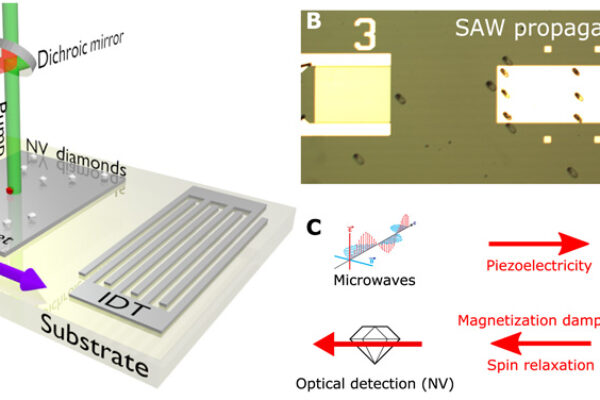
Diamond nanofilm slashes power for magnetic sensors
Each time today’s diamond-based sensors measure a magnetic field, they must first be blasted with 1 to 10 W of microwave radiation to prime them. The researchers found a new way to excite tiny diamonds with microwaves using microwatts, 1300 times less power, making it feasible to create magnetic-sensing devices that can fit into electronics such as mobile phones or medical systems.
“The best magnetic sensors out there today are bulky, only operate at extreme temperatures, and can cost tens of thousands of dollars,” said Dominic Labanowski, who helped create the device, which is made from nitrogen-infused diamonds, as a postdoctoral researcher in the department of electrical engineering and computer science. “Our sensors could replace those more difficult-to-use sensors in a lot of applications from navigation to medical imaging to natural resource exploration.”
Today’s sensors are created by bombarding a diamond with a jet of nitrogen gas can knock out some of its highly ordered carbon atoms, replacing them with nitrogen atoms. These nitrogen vacancy (NV) centres have unique properties. “You can use these NV centers as very powerful sensors, but traditionally their applications have been limited because it takes a lot of power to read them,” said Labanowski.
To detect magnetic fields, the NV centres are stimulted with high-power microwave radiation. Illuminating the NV centres with a laser allows the light to be absorbed and emitted by the nitrogen atoms, and the strength of the magnetic field is related to the strength of the emitted laser light.
To create the new voltage-driven ferromagnetic resonance (FMR) coupling sensor, the researchers placed diamond nanocrystals on a multiferroic film. This transfers microwave energy to the crystals much more efficiently. “This technique dramatically lowers the power consumption of the sensors and makes them usable for realistic applications,” said Labanowski. “With low-power NV sensors, you could imagine taking a room-sized magnetoencephalography machine and turning it into something like a helmet, dramatically reducing the size and the costs.”
The sensors could also be placed in planes or drones to aid in spotting rare earth metals underground, or used in cell phones to improve navigation. The technique could alos be used for quantum computing systems, say the researchers.
Related stories:
 If you enjoyed this article, you will like the following ones: don't miss them by subscribing to :
eeNews on Google News
If you enjoyed this article, you will like the following ones: don't miss them by subscribing to :
eeNews on Google News




